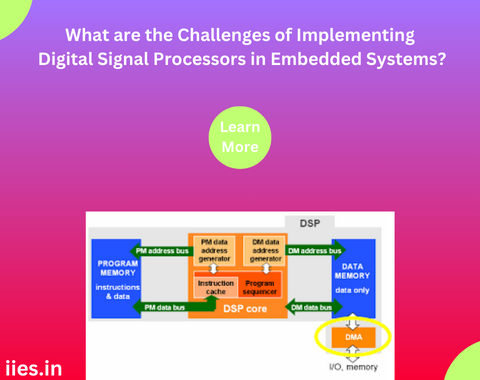
Embedded systems have become an integral part of our daily lives, seamlessly integrating into various devices to enhance functionality and performance. At the heart of many embedded systems lies a crucial component known as the Digital Signal Processor (DSP). This article aims to delve into the role of a DSP in an embedded system, exploring its functions, applications, and significance in shaping modern technology.
Embedded systems refer to specialized computing systems designed to perform dedicated functions within larger electronic devices. These systems are embedded into a wide array of applications, ranging from consumer electronics like smartphones and smart appliances to industrial equipment, medical devices, and automotive control systems. The efficiency and effectiveness of these embedded systems often hinge on the inclusion of a Digital Signal Processor.
A Digital Signal Processor is a specialized microprocessor designed to execute digital signal processing tasks with speed and efficiency. Unlike general-purpose microprocessors, DSPs are optimized for mathematical computations involved in processing signals. Signals in this context refer to data representing variations in physical quantities such as sound, image, or temperature.
Key Characteristics of DSPs:
Parallel Processing:
DSPs are designed to perform parallel processing, enabling them to handle multiple data streams simultaneously. This parallelism is crucial for real-time processing tasks, where timely and efficient execution is paramount.
Fixed-Point Arithmetic:
DSPs predominantly utilize fixed-point arithmetic, offering a balance between precision and computational efficiency. This characteristic makes them suitable for applications where a high level of precision is required, such as audio and video processing.
Specialized Instruction Set:
DSPs come equipped with a specialized instruction set tailored for signal processing tasks. This specialized set allows them to execute operations like multiplication and convolution more efficiently than general-purpose processors.
Applications of DSPs in Embedded Systems:
Audio Processing:
One of the most common applications of DSPs is in audio processing. DSPs play a crucial role in enhancing audio quality, implementing features like noise reduction, equalization, and compression. They are integral components in devices ranging from smartphones to high-end audio equipment.
Image and Video Processing:
In embedded systems, DSPs are employed for image and video processing tasks. They enhance image quality, implement image recognition algorithms, and enable video compression and decompression, contributing to the functionality of devices like surveillance cameras, medical imaging equipment, and digital cameras.
Communication Systems:
DSPs are extensively used in communication systems for tasks such as signal modulation, demodulation, and error correction. They are vital in ensuring reliable and efficient data transmission in applications like telecommunications, wireless communication, and networking equipment.
Automotive Applications:
Embedded systems in modern vehicles rely heavily on DSPs for tasks such as engine control, anti-lock braking systems (ABS), and in-car entertainment systems. DSPs contribute to the overall performance, safety, and efficiency of automotive electronics.
Medical Devices:
In the healthcare industry, DSPs are utilized in medical imaging equipment, patient monitoring devices, and diagnostic tools. Their ability to process signals in real-time is critical in applications where timely and accurate data analysis is essential.
Significance of DSPs in Embedded Systems:
Real-time Processing:
DSPs excel in real-time processing, making them indispensable in applications where immediate response and high-speed data processing are crucial. This is particularly important in fields such as telecommunications, audio processing, and control systems.
Power Efficiency:
DSPs are designed to execute specific tasks efficiently, consuming less power than general-purpose processors. This characteristic is vital in embedded systems, especially in battery-powered devices where power efficiency is a primary concern.
Cost-Effective Solutions:
The specialized nature of DSPs allows for cost-effective solutions in embedded systems. Their optimized architecture results in efficient use of resources, contributing to lower manufacturing costs for devices incorporating DSP technology.
Customization and Flexibility:
DSPs offer a high level of customization and flexibility, allowing developers to tailor their functionality to specific signal processing requirements. This adaptability makes DSPs suitable for a wide range of applications, from simple consumer electronics to complex industrial systems.
Expanding on the Role of Digital Signal Processors:
Sensor Fusion and IoT:
In the realm of Internet of Things (IoT), where a multitude of sensors collect data for various applications, DSPs play a crucial role in sensor fusion. They integrate data from different sensors, compensating for their individual limitations and providing a more comprehensive and accurate representation of the environment. This capability is essential in smart home devices, wearables, and industrial IoT applications.
Radar and Sonar Systems:
DSPs are fundamental components in radar and sonar systems, where accurate and real-time signal processing is imperative. They assist in target detection, tracking, and signal interpretation, contributing to the effectiveness of defense systems, maritime navigation, and weather monitoring.
Control Systems and Robotics:
Embedded systems in control applications, such as industrial automation and robotics, leverage DSPs for precise control algorithms. These processors enable quick response times and accurate control signals, ensuring the efficiency and safety of automated systems in manufacturing, logistics, and other industries.
Speech Recognition and Natural Language Processing:
As voice-activated technology becomes more prevalent, DSPs are at the forefront of speech recognition and natural language processing. These processors analyze and interpret audio signals, enabling devices like smart speakers and virtual assistants to understand and respond to human commands with remarkable accuracy.
In conclusion, the Digital Signal Processor plays a pivotal role in shaping the capabilities of embedded systems across diverse applications. Its specialized architecture, optimized for signal processing tasks, enables efficient and high-performance execution, contributing to the advancement of technology in fields such as audio processing, image and video processing, communications, automotive systems, and healthcare. As technology continues to evolve, the role of DSPs in embedded systems is likely to expand, driving innovation and enhancing the capabilities of electronic devices in our interconnected world.
Indian Institute of Embedded Systems – IIES